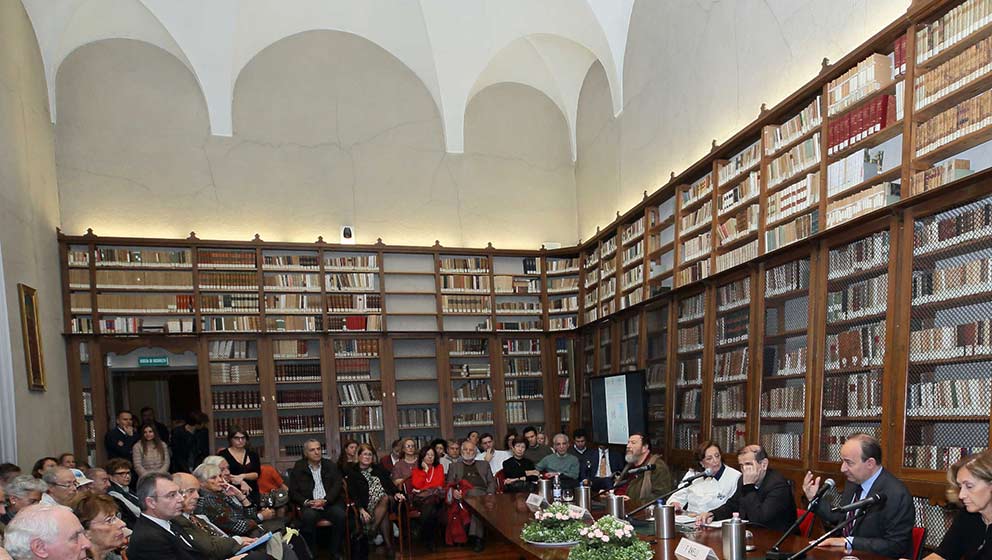
Fides quaerit, intellectus invenit (...) et rursus intellectus eum quem invenit adhuc quaerit.
La fede cerca, la ragione trova (...) e ancora la ragione cerca colui che ha trovato.
Sant’Agostino, de Trinitate, liber XV
La Sala Negri da Oleggio (fig. 25) è situata tra il Rettorato e l’Aula Magna, adiacente al Chiostro dorico, e si affaccia sul Giardino di Santa Caterina, tradizionalmente conosciuto come Giardino delle Vergini. Essa deve il suo nome al Conte Vincenzo Negri da Oleggio (1887-1976), grande studioso e bibliofilo del secolo scorso, che ha donato nel 1968 la preziosa raccolta libraria ospitata al suo interno. Il lascito era motivato dalla profonda amicizia che lo legava a Padre Agostino Gemelli e dalla volontà di rendere fruibile la raccolta. I libri della collezione trattano un arco cronologico che va dal Medioevo agli anni Settanta del ’900 e denotano la passione del Conte per la storia locale.
I filoni principali riguardano:
- la storia lombarda, con opere che vanno dal periodo della Repubblica Cisalpina a quello risorgimentale compreso un corposo gruppo di opuscoli propagandistici novecenteschi, dalla Grande Guerra all’epoca fascista;
- Milano, indagata soprattutto sotto il profilo storico, architettonico-urbanistico e degli enti assistenziali e benefici operanti nella città a partire dall’Ottocento;
- località brianzole e zone limitrofe.
Nella collezione spiccano manoscritti di particolare pregio, fra i quali un preziosissimo diploma autografo di Matilde di Canossa datato al 1106.
Sono presenti in questa sala alcune pregevoli testimonianze facenti parte del patrimonio artistico dell’Università Cattolica:
- gli arredi della sala donati anch’essi dal Conte;
- il frammento di una guglia del Duomo di Milano in marmo di Candoglia, probabilmente donata dal cardinale Schuster;
- una statua bronzea di Antonio Carminati del 1891, esempio di realismo sociale, raffigurante un bambino poveramente vestito che dorme stremato dal lavoro notturno, seduto su di un sacco di farina;
- due tavolette dipinte datate alla prima metà del XVI secolo, attribuite a Francesco Rizzo di Bernardo da Santa Croce, rappresentanti due sante riconoscibili dagli attributi iconografici: la ruota per Santa Caterina d’Alessandria e la tenaglia che stringe un dente per Sant’Apollonia.
Curiosità
In epoca medievale, quando i chiostri di Sant’Ambrogio ospitavano il monastero benedettino, qui era situato lo “scaldatoio”, in latino calefactorium: era l’unico ambiente riscaldato del monastero, dove i monaci potevano passare per scaldarsi prima del riposo o durante lo studio e dove preparavano gli inchiostri e i colori per i codici e le miniature.
L’Aula nel corso degli anni è stata visitata da personaggi illustri, tra questi è importante ricordare Papa Giovanni Paolo II, in visita all’Università il 22 maggio 1983 in occasione del Congresso Eucaristico Nazionale.
Attualmente costituisce una delle più belle aule di rappresentanza dell’Ateneo: proprio qui hanno luogo discussioni delle tesi di laurea, convegni, tavole rotonde, seminari ed altri eventi importanti
Negri da Oleggio Room
Fides quaerit, intellectus invenit (...) et rursus intellectus eum quem invenit adhuc quaerit.
Faith searches, Reason finds, and still Reason searches him whom it has found.
St. Agustine, De Trinitate, Liber XV
The Negri da Oleggio Room (fig. 25) is located between the Rectorate and the Aula Magna (Lecture Theatre), next to the Doric Cloister, and overlooks the Garden of St. Catherine, traditionally known as the Garden of the Virgins. It takes its name from Count Vincenzo Negri da Oleggio (1887-1976), a great scholar and bibliophilist from last century. In 1968, he donated the precious book collection housed in this room to the University.
This bequest was due to his deep friendship with Father Agostino Gemelli and by his wish to make the collection available for everyone. The books of the collection span from the Middle Ages to 1970s and show the Count’s interest in local history. The main branches of research are:
- The history of Lombardy, from the Cisalpine Republic to the Risorgimento, and a substantial group of 20th century propaganda leaflets, from the Great War to Fascism;
- Milan, analysed from an historical, architectural and urban point of view, also focusing on the charities working in the city from the 19th century onwards;
- Sections regarding Brianza and the nearby area.
In the collection, stand out manuscripts of great importance, like a very precious 1106 authentic diploma belonging to Matilda of Canossa.
This Room also houses some exquisite evidence of the artistic heritage of the Università Cattolica:
- The furniture of the Room, donated by the Count;
- The fragment of a Candoglia marble spire from the Dome of Milan, likely donated by Cardinal Schuster;
- A 1891 bronze statue by Antonio Carminati, an example of social realism, portraying a poor sleeping child, exhausted for his night shift at work, sitting on a sack of flour;
- Two painted wooden boards from the 14th century, attributed to Francesco Rizzo di Bernardo da Santa Croce, portraying two female Saints, recognizable by their iconographic characteristics: the wheel for St. Catherine of Alexandria and the pincers gripping a tooth for St. Apollonia.
Fun fact
In the Middle Ages, when St. Ambrogio’s Cloisters used to house the Benedictine monastery, this was the location of the so-called Calefactorium. It was the only heated place in the monastery, where the monks could go before resting or studying and where they prepared their inks and colours for their codes and miniatures.
Over the time, the Room has been visited by eminent people, such as, for example, Pope John Paul, who visited the University on 22th May 1983, during the National Eucharistic Congress. Today, this is one of the most beautiful boardrooms in the University, often used for graduation ceremonies, congresses, panel discussions, seminars and other important events.

